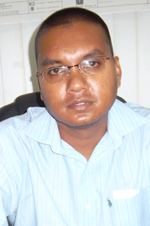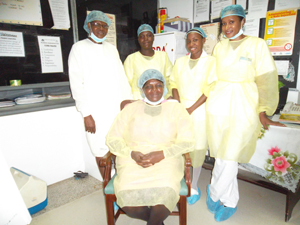Latest update November 18th, 2024 1:00 AM
Latest News
- ExxonMobil eyeing 8th project despite Jagdeo says 7th ‘iffy’
- City Mayor slams govt. for favouring foreign companies over locals for tax concessions
- Pope Francis urges inquiry into Gaza genocide allegations
- New aircraft for GDF commissioned
- Importing truck drivers from Bangladesh, a disrespect to Guyanese – Norton
The GPHC’s Burn Care Unit – a crucial lifeline in serious circumstances
Apr 14, 2013 News
By Sharmain Grainger
Many were convinced that there was no hope for 39-year-old Asgar Mohamed when a power cable snapped in the vicinity of the Stabroek Market in Georgetown, causing him severe burns to his left arm. There was nothing to suggest that the South Better Hope, East Demerararesident would recover from the injury which had him clinging to life for weeks as he lay in an isolated room in the Burn Care Unit of the Georgetown Public Hospital Corporation (GPHC).
Even medical officials of the public hospital were not confident that Mohamed would have been able to recover from his injury. But little did they know that he would have turned out to be one of the institution’s success stories. Although it required that his left arm be amputated, Mohamed was able to walk out of the Burn Care Unit a few weeks ago, signalling that he is well on his way to full recovery.
According to Dr Shilindra Rajkumar, the Surgical Registrar attached to the Burn Care Unit, it is never a straightforward task attending to patients with varying forms of burns. In fact it is oftentimes a battle to save some patients’ lives. He asserted that Mohamed will go down in the history of the Burn Care Unit as “one of the most difficult cases we would have seen. Most had given up on him and we can actually say he was a true success story.”
Dr Rajkumar, a product of the first batch of the Surgical Post Graduate Programme offered at the GPHC, explained that burn patients were initially managed by general surgeons, but at the time the outcome was less than what it should have been.
However, following a visit by a team of Canadian medical professionals it was recognised that there was a need for the burn cases seen at the institution to be managed in a more systematic manner. One of the keys to achieving this goal was to designate an area specifically for the management of burn patients since according to Dr Rajkumar “patients used to be managed on an open ward where there were a lot of cross infections. There was need for patients to be isolated,” he noted.
Acting on the recommendation, the administration of the GPHC made the bold decision to establish the Burn Care Unit in 2002 with the support of Canadian Charitable organisations which donated the necessary equipment. Two associated Charities – the Guyana Burn Care Foundation and the Canadian Reconstructive Surgery Foundation – both based in Canada, are still today offering support, even as the Unit’s operation evolves.
Initially it was managed by visiting Chinese plastic surgeons, but eventually it was observed that there were some language barriers which warranted that a local medical professional be seconded to the Unit.
Dr Rajkumar was the logical choice, since he had completed a Burn Care course himself in Canada. Aided by a Chinese Consultant and a Medical Officer, he took up the position at the Unit in 2008 and according to him “I started working closely along with the Chinese (doctors) and we have been trying to get things more streamlined.”
Currently the Burn Care Unit is a six-bed, fully air conditioned facility that provides isolated care to patients with burn injuries. Patients, according to him, are admitted based on rigidly monitored criteria, given the accommodation limitations.
He explained that once someone meets the criteria they are admitted to the Unit and moves are immediately made to commence resuscitation. Often this is a challenge, he noted, since some of the patients admitted do not come from within close proximity as they are transferred from outlying areas.
“They usually come quite a bit late and most of them are not properly resuscitated. We normally start at a step back,” he added, while pointing to the need for persons trained in the area of burn care management at the various health facilities to commence the process. “A lot of the outcome depends on these initial interventions,” he said.
Currently the Unit attends to close to 50 patients per year and of that amount there is a mortality rate of about 30 per cent. Dr Rajkumar explained that “about 17 of our 50 patients who get admitted would die and a lot of the deaths are not preventable… but some of it…if we do have the equipment to improve care we can drop that mortality rate to somewhere about 10 per cent.”
Although there are currently shortcomings within the Unit, such as the lack of ventilators, Dr Rajkumar disclosed that there are ambitious long term plans in the pipelines which will see the Unit being outfitted with its own adjoining operating room and rooms with ventilators.
“We are looking to have a mini Intensive Care Unit, along with an operating room, where we can actually function independently from the running of the rest of the hospital. So the idea is for us to manage our own patients with help from doctors out of the Unit, yes, but we will be able to determine when we have our surgeries, when our patients can be in ICU care, because right now we don’t have that privilege.”
He disclosed that an area has already been earmarked for the operating theatre.
Dr Rajkumar is optimistic that in another 10 years or so, the Unit will see at least two of its existing rooms outfitted to the standard of an ICU, complete with invasive monitoring and ventilators.
He has already prepared a protocol for the improvement plan for the Unit and a detailed list of the requisite equipment has been presented to the hospital’s administration. Some of the items have been acquired, but additional supportive care materials are yet to be had.
Adequate Nursing Care
In the interim, though, there is no lack for nursing care within the Unit which has been effectively managed by Sister Yonette Garnett ,who has been at its helm since its introduction, save for a three-year period when she was transferred to Mabaruma, and while she completed her midwifery training.
She disclosed that the Unit, which is a vital part of the public hospital, has been noticeably evolving over the years, pointing out that the capacity for grafting and even outpatient care are offered.
Patients with burns of 20 per cent or more of the body affected in areas of the face, chest, palms, soles of feet and the genital areas are attended to. These, she explained, maybe patients with first, second, third or even fourth degree burns who are referred from other medical institutions or are rushed there with their injuries.
All patients are required to be passed through the Accident and Emergency Unit, she noted. “The doctor there would see the patients and then recommend that they be seen by the Burn Care Unit’s doctor, who would usually conduct a further assessment,” said Sister Garnett.
Once patients are admitted, nurses are always on hand to monitor and ensure that they are adequately infused with intravenous fluids, as according to Sister Garnett, a patient with burns would normally lose fluids through their injuries.
Ahead of caring for patients, though, all nurses or even anyone seeking to visit patients must be properly attired with protective gear inclusive of gowns, caps and masks in order to minimise the potential of patients being subjected to bacterial infections.
“We know bacteria are always in the atmosphere, but we don’t see them, and since patients with burns have their top skins or the protective barrier of the body removed, if exposed to bacteria it can be harmful to them, hence the need for the protective gear.”
With 12 nursing staffers operating on a three-hour shift system, the Unit operates on a 24- hours-a-day, seven-days-a-week basis.
Sister Garnett explained that some of the cases that are seen in the Unit have even been linked to suicidal attempts, thus cases are required to be investigated by Social Workers who are informed of all new cases.
While the nurses attached to the Unit are always prepared to take on any challenge that they encounter, Sister Garnett did speak of the importance of special training for nurses to bolster their existing skills. She also mentioned that the hours of dressing that a nurse may be required to provide to a patient could be very lengthy adding that “you might have to work through your lunch break just to get through hours of needful dressing…It requires a lot of patience and tolerance.”
Although their backs might be in pain when they would have completed a patient’s dressing, the Ward Manager noted that sometimes a mere word of appreciation is a satisfying reminder as to why they are still attached to the Unit.
As such, she noted that those endeavouring to venture into such an arena must first seek to be dedicated and embrace a strong sense of commitment.
“Once you have those you are good to go,” she noted as a satisfying smirk formed on her face, as she noted that her’s as well as the other nurses’ time is well spent providing crucial care in the very vital Burn Care Unit.
Share this:
- Click to print (Opens in new window)
- Click to email a link to a friend (Opens in new window)
- Click to share on Facebook (Opens in new window)
- Click to share on WhatsApp (Opens in new window)
- Click to share on Twitter (Opens in new window)
- Click to share on Pinterest (Opens in new window)
- Click to share on Pocket (Opens in new window)
- Click to share on Tumblr (Opens in new window)
- Click to share on Reddit (Opens in new window)
- Click to share on LinkedIn (Opens in new window)
Related
Similar Articles

The Glenn Lall Show | November, 15th, 2024
Follow on Tik Tok @Glennlall
THE BLUNT OF THE DAY

Sports
Nov 18, 2024
-YMCA awaits in $1M Showdown on November 23 Kaieteur Sports –Futsal fans were treated to a thrilling spectacle at the Retrieve Hard Court in Linden on Saturday evening as Hard Knocks and YMCA...Features/Columnists
Traditional media is still king
…Peeping Tom Kaieteur News-Election campaigns are a battle for attention, persuasion, and votes. In this digital age,... more
Rising Gun Crimes in the Caribbean: Urgent Action required by all
By Sir Ronald Sanders Kaieteur News – There is an alarming surge in gun-related violence, particularly among younger... more
Publisher’s Note
Freedom of speech is our core value at Kaieteur News. If the letter/e-mail you sent was not published, and you believe that its contents were not libellous, let us know, please contact us by phone or email.
Feel free to send us your comments and/or criticisms.
Contact: 624-6456; 225-8452; 225-8458; 225-8463; 225-8465; 225-8473 or 225-8491.
Or by Email: [email protected] / [email protected]
Weekend Cartoon
















